
Week #45 Organized Home Challenge
Create An Emergency Preparedness Kit
In this week's challenge we'll make an emergency preparedness kit to make sure our family is secure in the case of a disaster or other emergency, plus do a few other safety related tasks around our homes as well.
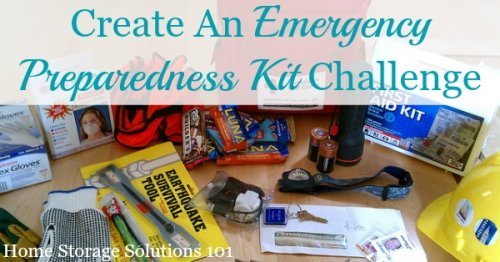
Emergency situations and disasters can happen. It isn't something we like to think about, but just turning on the news, or even hearing stories from our friends and family members, makes it clear that we shouldn't just ignore the possibility because it is very real.
While that is the bad news, the good news is that we can prepare for those emergencies, and doing so is something that can help us feel a bit more in control again, and ease our worry.
It can also mean the difference between being slightly comfortable in a bad situtaion, as opposed to really uncomfortable, or even more importantly, sometimes it can be the difference between life and death.
That's why in every organized home there should be an emergency kit that can help you weather whatever disasters most likely would effect the area you live in, as well as taking several other safety precautions.
Are you new here? The Create An Emergency Preparedness Kit Challenge is part of the 52 Weeks To An Organized Home Challenge. (Click the link to learn how to join us for free for future and past challenges if you aren't already a regular reader).
Step 1: Be Prepared For Fires, Natural Disasters & Extreme Weather
The first step in this week's challenge is to take steps to become prepared for fires, natural disasters and extreme weather that can occur in or surrounding your home.
The natural disasters and types of extreme weather you can expect and should prepare for, to an extent, are different in each area of the country, and really the world.
So consider this more general advice that I'm providing below in the lens of those particular disasters, such as earthquake, tornadoes, hurricanes, or something else entirely, and make sure whatever preparations you take will be adequate for the type of disasters you're more likely to experience.
Everyone, of course, needs to prepare for the possibility of house fires.
Talk To Your Family & Develop A Plan, And Practice It
For each type of emergency or disaster that your household needs to prepare for, you need to talk to your family and develop a plan for how to prepare for it.
It is not enough for you to know the plan, and no one else. That is why family involvement is so important, because in an emergency everyone needs to know what to do, to the extent that they're capable of acting on their own.
It is also not enough for everyone to just discuss it. Actually practicing the steps is also extremely important.
I've written an article about how to make a fire escape plan for your family. It can help you not only to do exactly that, but also be used as a model for how to make similar plans for other natural disasters that may occur.
In addition, here's some more general tips that you should take to be prepared for these emergencies:
- All adults, teens and older children should know how to turn off the water, gas and electricity at the main switches.
- Identify the safest places in your home for earthquakes and tornadoes.
- Consider and map out escape routes from each room in your home. Practice them at least twice a year.
- Choose two emergency meeting places for your household, one outside your home, but close by, and one outside the neighborhood in case you are gone when the disaster occurs and are not able to get back to your home again.
- Keep a working flashlight on every floor of your home and know where to find them.
- Make sure you have placed fire extinguishers in all the important spots in your home. You can reference these fire extinguisher placement guidelines for more information.
- Make sure everyone in your home (even kids) know how to use a fire extinguisher.
- Install smoke detectors throughout your home, and change the batteries yearly.
- Routinely check your smoke detectors, fire extinguishers and flashlights to make sure they are in good workig order. You can use Daylight Saving Time's beginning and end as a reminder if you wish, to do it twice annually.
- Make a plan for your pets as well, and consider that many emergency or disaster shelters do not allow pets.
Make Sure You've Got A Home Inventory
If a fire or natural disaster occurs, or you're the victim of theft, it is important to know what the contents of your home were, so that you can work with your home insurance company to replace your belongings. This is the main purpose of a home inventory.
I actually believe this is so important that I've added creating a home inventory as an entire challenge in this 52 Week Organized Home Challenge, and we'll be working on it together later this year.
Suffice it to say during this challenge that you need to keep your home inventory in a safe place, with at least one copy preferably outside your home, such as at a trusted friend or relatives home, or in your safe deposit box. This is just logical because if your home is damaged or destroyed in some way it might make your copy of your home inventory stored there inaccessible.
When protecting your home inventory you should also make sure you've taken steps to protect and properly store your vital records, which are some of the most important documents in your home. Here's my article on how to make a vital records file, and options for ssafeguarding its contents (we worked on that file as part of the Organize Files Challenge earlier this year).
Emergency Contact List Should Be Handy In Case Of Crisis
Finally, it is important for everyone in your home to have ready access to an emergency contact list. If you don't have one yet click the link for a free printable form you can fill out.
Of course, many of you may have already filled out this form earlier in the Challenge, as part of the Organize Contact Information Challenge.
Step 2: Create A 3 Day Emergency Kit
The second step in this week's challenge is to create a three day emergency kit.
The reason is that emergency situations may limit your access to food, water, heat or other necessities and you need to be prepared.
Some people suggest having more than just three days worth of supplies, and I am not saying you don't want to go above and beyond, but if you don't have any type of emergency kit at all I suggest starting with a three day version, because it is really the minimum you should have.
I've created a complete emergency supply list for you to use when creating your kit, which includes a free printable that you can reference whenever you need it.
One of the things listed on this supply list is a first aid kit.
Please remember that we will work on our first aid kit for our home during the Organize Medicines & First Aid Kit Challenge in just a couple of weeks. But you should consider having a separate first aid kit for your emergency kit, because in an emergency you might need to grab your emergency kit quickly, and not have a chance to run to where you normally keep your first aid kit as an additional stop.
If you do not want to create your own personalized emergency kit, or you just don't have time to create one right now, you can purchase a three day emergency supply kit (also known as a 72 hour kit) (referral link). It will not contain exactly the things on the list I created and mentioned above, but if you don't have time to do anything else, it is much better than nothing.
Once you create or purchase your kit you have to remember to also regularly replace supplies as they expire or get too old.
In addition, as your family changes circumstances and grows older you need to update things such as the size of clothes or shoes in the kit, add supplies for new household members, or update medications or even add extra eyeglasses for a family member who just got a new prescription, for example.
To do all these types of updates I suggest getting into a routine of checking and updating your emergency kit twice a year, both at the beginning and end of Daylight Saving Time.
To get more information on periodically updating your kit, as well as other emergency supplies in your home, check out this article on how to declutter and replenish emergency supplies.
Step 3: Create A Car Emergency Kit
We need an emergency kit for our house, but we also need one for our car(s) since we are in them a lot as well.
This is important all year round, but becomes especially important during winter weather as well.
So step 3 of this challenge is to create an emergency kit for each of your cars. I've created an article (at the link above) listing all of the items you should keep in your kit, and it includes a printable checklist, which you can use when creating your kit.
Step 4: Child Proof Your Home To The Extent Necessary
Finally, the last step of this week's challenge is to child proof your home to the extent necessary.
Obviously, if you have no small children living in your home, nor any that visit frequently, this won't take you nearly as long as for those with small kids.
But we need to acknowledge that emergencies don't just happen with natural disasters, or large calamities like house fires, but can also just happen when we turn our back for just a second.
Kids will be kids and it is our job, as caregivers, to provide a safe environment for them, especially for kids so young they just don't know better yet.
Here's a quick list of safety tasks you should consider:
- Install safety latches or locks on cabinets and drawers where potentially dangerous objects are stored;
- Keep all poisons, medications, knives and other sharp objects out of reach;
- Anchor tall furniture to the wall to prevent it from toppling;
- Cover sharp edges of furniture;
- Ensure children cannot easily get to dangerous areas (including swimming pools) without supervision, and install safety gates inside the house as necessary;
- Shield electrical outlets with covers;
- Hanging wires and cords, including long window-blind cords, are out of reach;
- Small objects that could be choking hazards are out of reach.
Listen To Taylor's Video Tips For This Week's Organized Home Challenge & Declutter 365 Missions
Do you want more in-depth tips and instructions for how to do this week's missions and challenge all about emergency preparedness? If so, I've got recorded video tips from me, Taylor, from the video archives in the Declutter 365 Premium group, all about this week's challenge and missions.
These video tips are available on demand in the archives, once you're a member of the group.
In Week #45's video I discussed the following topics, among others:
- Why it's important to be prepared for emergencies
- How to create a 72 hour emergency kit, and then keep it updated
- Declutter 365 missions for the coming week
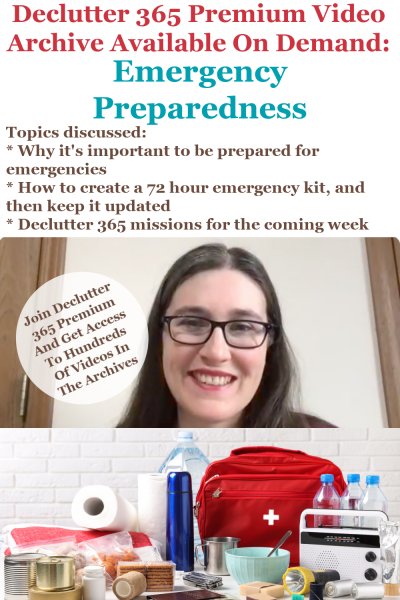
I suggest watching the video archive for the week, perhaps while you're doing some decluttering or cleaning around your home, before starting the week's missions and Challenge, and then you'll be able to breeze through this week's worth of decluttering missions, as well as organize what's necessary for the 52 Week Organized Home Challenge, based on the advice and instructions within those videos.
It really is like having me, Taylor, available, 24-7, as your decluttering and organizing coach, for every area of your home!
Plus, once you're a member of Declutter 365 Premium you get access to not only this video, but all the videos for the 52 weeks of the year, for 5 years (that's over 260 videos available in the archives!)

Get This Miscellaneous Decluttering Checklist + 32 Other Decluttering Checklists For Your Home
Right now you're decluttering your home, and there's a lot of items to declutter.
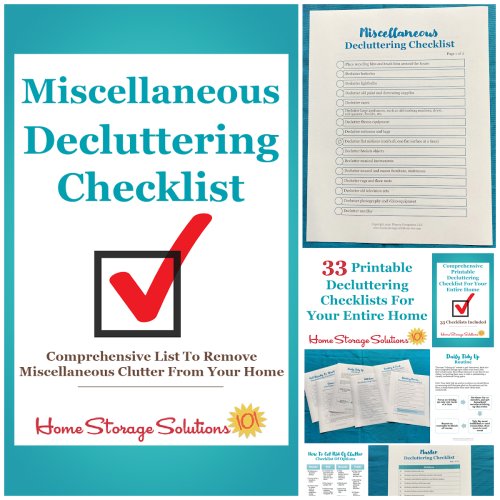
I've done the hard work of breaking down these tasks into smaller more manageable steps for you, so you don't get overwhelmed or worry you're forgetting a task, and you can go at the pace you want, whether that's fast or slow.
In addition, you can tackle these decluttering tasks in whatever order you want when you use these checklists!

Tell Me How The Create An Emergency Preparedness Kit Challenge Is Going For You
I would love to know how this week's Create an Emergency Preparedness Kit Challenge is going. You can tell me your progress or give me more ideas for how you've done it in the comments.
I also love before and after pictures of organized rooms and areas, and would love to see some of yours. Submit your pictures (up to four per submission) and get featured in the Creative Storage Solutions Hall of Fame. You've worked hard to get organized, so now here's your chance to show off!
Sneak Peek For Next Week's Challenge
We're working on our homes slowly, one area at a time, so don't get too distracted from this week's challenge.
However, I know many of you do like to know what's coming next, so I'll tell you.
Next week we're continuing on with the theme of focusing on our health and safety by organizing our medications and creating a first aid kit.
Make Sure You Make The Most Of These 52 Organizing Challenges
Get your copy of the printable one page 52 Week Organized Home Challenge schedule for the year here, so you can see all the challenges we're working on.

Further, if you'd like to join a community of others who are all commmitted to these organizing challenges and corresponding decluttering missions, and want more interaction with me, Taylor, plus video archives of Taylor providing more tips for each of these challenges and missions I encourage you to join the private and exclusive Declutter 365 Premium Facebook group (you can learn more about it at the link).
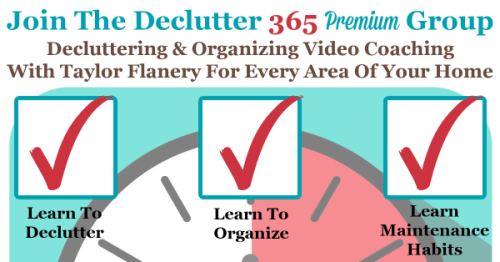
In addition, have you gotten your Declutter 365 Products yet, to make sure you can get even more assistance with decluttering and organizing your home this year? There is a digital and printed version of the full 2026 Declutter 365 calendar, as well as add-ons, such as daily text messages, planner stickers, and a Premium Facebook group, as well as a pack of decluttering checklists.

Top photo courtesy of Global X
Some links on this page are affiliate links, meaning that if you purchase a product through them I receive a small commission which helps me provide this information to you for free, plus support my family. My integrity and your satisfaction are very important to me so I only recommend products I would purchase myself, and that I believe would benefit you. To learn more please see my disclosure statement.
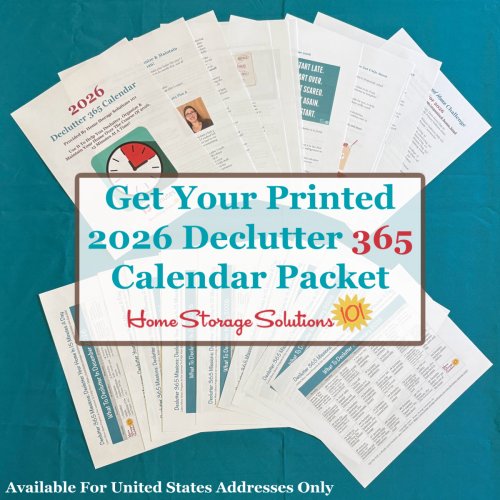
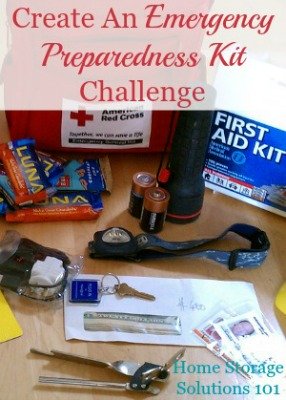



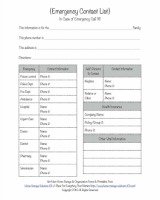
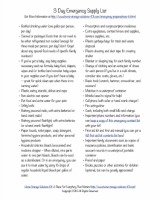
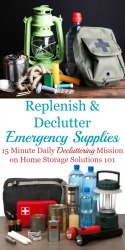

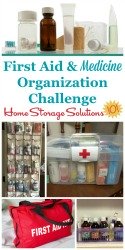
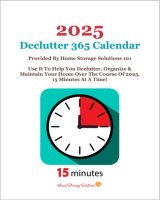
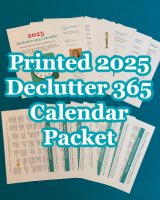
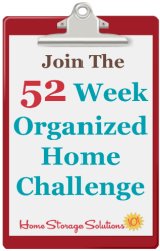



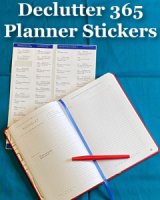

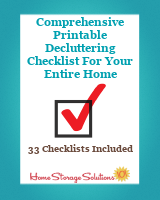


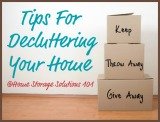
Share Your Comments, Tips & Ideas
I would love to hear from you, sharing your thoughts, questions, or ideas about this topic, so leave me a comment below. I try to always respond back!